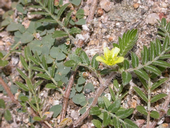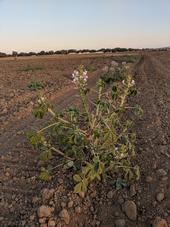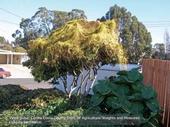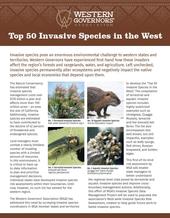- Author: Ben Faber
- Re-posted by: Gale Perez

From the Topics in Subtropics blog
The following article is from the UC ANR Integrated Pest Management website, authored by Cheryl Wilen.
http://ipm.ucanr.edu/PMG/PESTNOTES/pn74128.html
Puncturevine (Tribulus terrestris) is an aptly named summer annual found widely in California. Native...
- Author: Guy B Kyser
- Author: Mohsen Mesgaran

Dr. Mohsen Mesgaran, who joined the Weed Science Group this year as our weed ecophysiologist, found this plant growing on the research farm at UC Davis.
African spiderflower is a summer annual broadleaf plant in the caper family (Cleomaceae), growing up to 3 ft tall and wide. The flowers are white, somewhat tubular, with long red-to-orange stamens (see photos below). Interestingly, African spiderflower plants have three types of flowers - male, female, and hermaphroditic.
We have no idea how this plant got here. It is native to Africa, where the leaves are used as a vegetable; it is now widespread and invasive in many tropical to subtropical parts of the world. The USDA
- Posted by: Gale Perez

From the Pest in the Urban Landscape blog • June 6, 2018
When people think of parasites, often what comes to mind are blood-sucking insects like bed bugs, head lice, and fleas or other bodily invaders on or in humans and other animals. But plants can have parasites too. Most of us are familiar with mistletoe but there is another parasitic plant you may not have heard about:...
- Author: Brad Hanson

Last Thursday (March 15, 2018), the Western Governors' Association released its first ever list of the top 50 invasive species (25 terrestrial, 25 aquatic) important in the western US. This list includes a number of plant, animal, insects, and pathogens.
Weeds were 18 of 25 in the terrestrial list and 10 of 25 and in the aquatic list. Both lists had weeds in the #1 slot (tamarisk and Eurasian watermilfoil, respectively.
Here's a link the the press release: http://westgov.org/news/wgas-top-50-invasive-species-in-the-west-offers-first-regional-report
Here's a link to...
- Author: Brad Hanson
https://www.youtube.com/watch?v=U-xC5Ml0oQs
I was forwarded the link above to what I thought was going to be simply a funny tumbleweed video (apparently I got tired of watching kittens on vacuum cleaners...) but realized it also had a story about some really interesting research from UC Riverside on tumbleweeds.
The work, conducted by Welles and Ellstrand, reports on the range expansion of a hybrid between two different members of the genus Salsola (both of which are sometimes known by various common names such as Russian thistle). Here's a link to the article and video:


